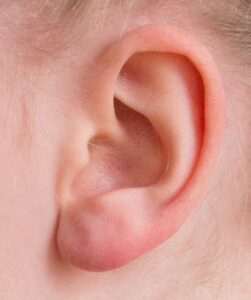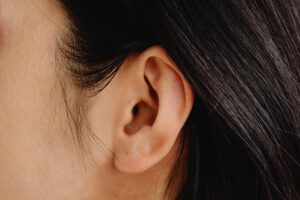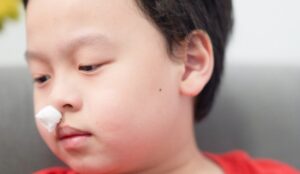Recently, as the weather has turned colder, many children have been prone to respiratory infections, often showing symptoms such as colds and coughs. In severe cases, they may develop bronchopneumonia. Just when parents think their child's condition has improved after treatment, they may notice discomfort in the ears. Some younger children may start crying frequently, pulling at their ears, or even developing a fever. Parents should not overlook these signs, as they may indicate acute otitis media (AOM).
What is Acute Otitis Media?
Acute otitis media (AOM) is a very common childhood illness. According to statistics, nearly 50% of children experience AOM at least three times in their lifetime. This condition is more prevalent in winter, frequently occurs in spring and autumn, and is less common in summer.
Because a child’s Eustachian tube (the passage that connects the middle ear to the throat) is shorter than an adult's, viruses or bacteria can more easily enter, leading to infections and inflammation.
Symptoms of Acute Otitis Media in Children
Recently, a child who had just recovered from a cold went to the park to play. After returning home, they felt one ear was blocked, as if there was a layer of paper covering it. The next day, the other ear developed the same sensation. Fortunately, the child did not feel pain or have a fever. After a doctor's diagnosis, it was confirmed to be acute otitis media, though not severe. The condition was treated with medication.
Common symptoms include:
- Ear pain (If the child is very young, they may cry frequently or pull at their ears.)
- Hearing loss (The child may respond more slowly to parents or even fail to notice when spoken to.)
- Fever (Usually above 38°C / 100.4°F)
- Ear discomfort
- Pain when swallowing, leading to a loss of appetite
- Eardrum perforation, causing ear discharge
If your child exhibits these symptoms, they most likely have acute otitis media.
What Causes Acute Otitis Media?
Acute otitis media is caused by either a viral or bacterial infection. The most common causes include:
- Recent cold or flu: Excessive nasal mucus makes it easier for bacteria to enter the ear.
- Allergies: Allergic rhinitis can cause nasal congestion and swelling, blocking proper air circulation in the ear.
- Environmental factors: The harmful effects of secondhand smoke should not be underestimated. Children who are frequently exposed to secondhand smoke are more likely to develop otitis media.
- Immature Eustachian tubes: Since a child’s Eustachian tube is shorter, bacteria can more easily travel from the nasal passages to the middle ear.
What Should Parents Do If Their Child Has Otitis Media?
- Apply a warm compress to the ear to relieve pain.
- Keep nasal passages moist, as this helps with mucus drainage.
- Elevate the child’s pillow slightly to reduce ear pressure.
Medical Treatment Options
- Some cases of acute otitis media resolve on their own, so if the condition is mild, the doctor may suggest home observation first.
- If the child has a fever, the doctor may prescribe antipyretics (fever reducers) and oral antibiotics, which usually need to be taken for at least one week.
- For children with recurrent or severe infections, a myringotomy (ear tube placement) may be necessary, particularly for those who experience frequent ear infections or poor recovery after treatment.
How to Prevent Acute Otitis Media in Children?
- Boost immunity to reduce colds (breastfeeding can help strengthen the child’s immune system).
- Maintain hygiene by washing hands frequently and ensuring good ventilation.
- Avoid exposure to secondhand smoke.
- Encourage physical activity to improve overall health.
- For infants, avoid excessive bottle-feeding, as milk can flow back into the ear, increasing the risk of infection.
Frequently Asked Questions (FAQ)
Q1: Is acute otitis media contagious?
A: No, but if a child has a viral cold, they can spread the virus, increasing the risk of infection in others.
Q2: If my child has ear pain but no fever, should I see a doctor?
A: It depends on the severity of the pain. If the pain is mild, you can observe for 48 hours. If the child is in significant discomfort, seek medical attention as soon as possible.
Q3: Can acute otitis media affect hearing?
A: In most cases, no. However, recurrent infections may lead to long-term hearing issues.
Q4: What if my child has frequent ear infections?
A: If a child experiences three or more infections in a year, doctors may recommend ear tube surgery (tympanostomy tubes) to help reduce recurrence.
Key Takeways
Although acute otitis media is a common childhood illness, it still requires attention from parents. Early detection and treatment can help prevent complications. By reducing colds, strengthening immunity, and maintaining good hygiene, parents can help lower the risk of AOM.
Reference
American Academy of Pediatrics (AAP) – This organization provides comprehensive guidelines on common childhood illnesses, including acute otitis media.
https://pediatrics.aappublications.org/
Centers for Disease Control and Prevention (CDC) – The CDC offers information on ear infections, their causes, symptoms, and preventive measures.
https://www.cdc.gov/ncbddd/hearingloss/facts.html
Mayo Clinic – Mayo Clinic has detailed articles on acute otitis media, including symptoms, causes, and treatments.
https://www.mayoclinic.org/diseases-conditions/ear-infection/symptoms-causes/syc-20351559
National Health Service (NHS) – The NHS provides information on childhood ear infections and treatments available.
https://www.nhs.uk/conditions/ear-infection/
World Health Organization (WHO) – The WHO offers insights into preventing respiratory infections, which are related to otitis media.
https://www.who.int/news-room/fact-sheets/detail/respiratory-infections












